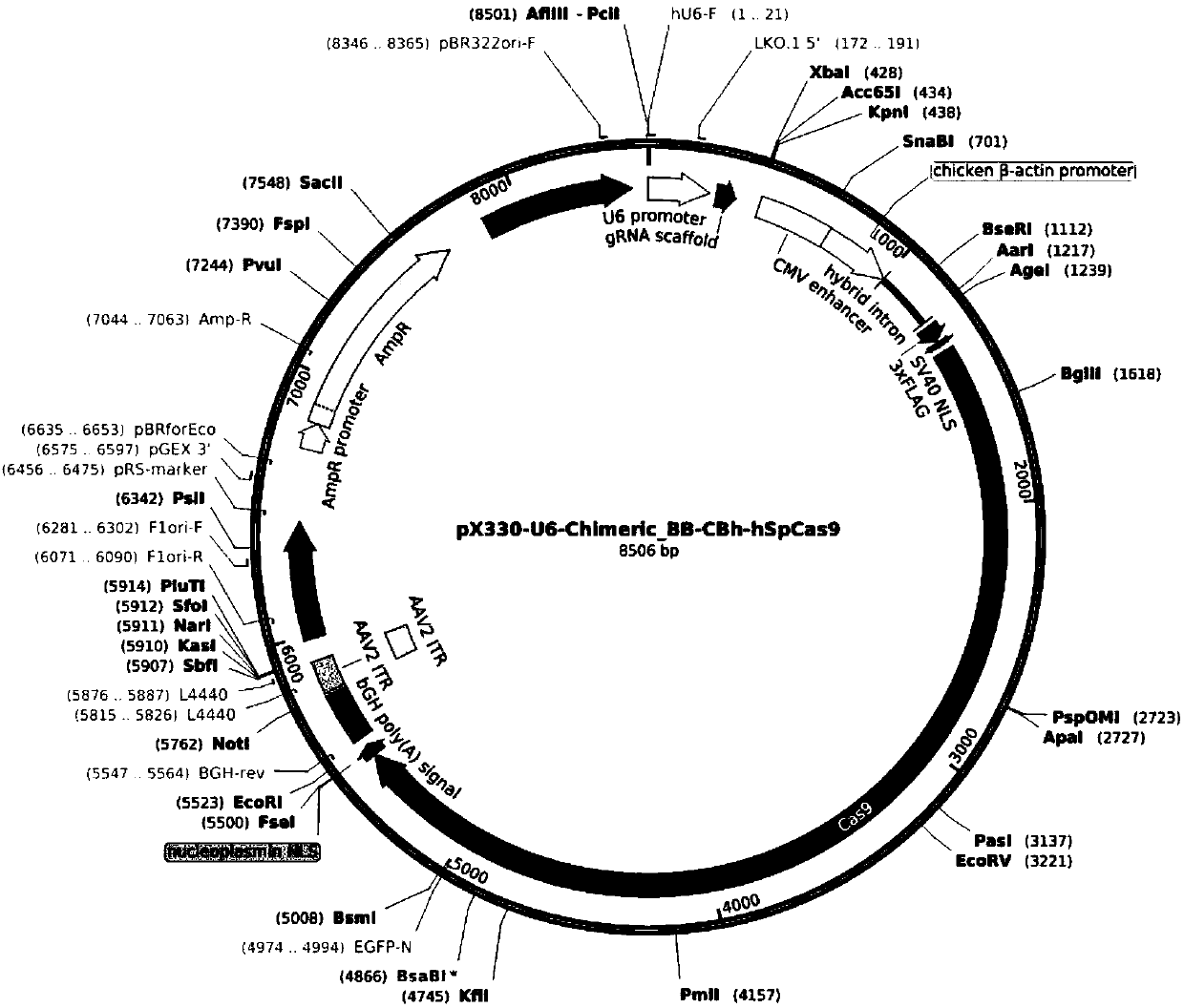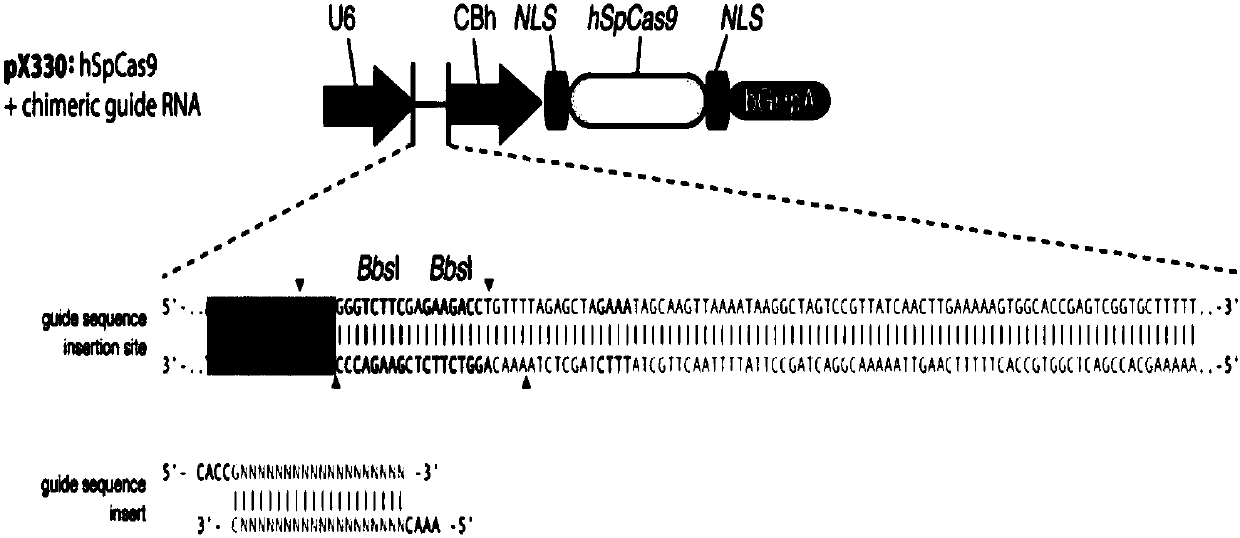Method for performing CASP3 gene knockout on mesenchymal stem cell through CRISPR-CAS system
A cell gene and stem cell technology, applied in the field of CASP3 gene editing, can solve the problem that siRNA cannot stabilize inheritance, and achieve the effect of high knockout efficiency and stable passage
- Summary
- Abstract
- Description
- Claims
- Application Information
AI Technical Summary
Problems solved by technology
Method used
Image
Examples
Embodiment 1
[0055] Embodiment 1, construction of CRISPR expression vector
[0056] gRNA design
[0057] According to the gene sequence of the target gene, through the applicant's unique optimization design method, the specific form of sgRNA obtained through specific screening is as follows:
[0058] CASP3-sgRNA1:5'to 3'ttggaaccaaagatcataca
[0059] CASP3-sgRNA2:5'to 3'ggaagcgaatcaatggactc
[0060] CASP3-sgRNA3:5'to 3'aatggactctggaatatccc
[0061] CASP3-sgRNA4:5'to 3'atgtcgatgcagcaaacctc
[0062] CASP3-sgRNA5:5'to 3'tgtcgatgcagcaaacctca
[0063] CASP3-sgRNA6:5'to 3'ggaataatttttggaacaaa
[0064] CASP3-sgRNA7:5'to 3'gatcgttgtagaagtctaac
[0065] CASP3-sgRNA8:5'to 3'acccaaacttttcattattc
[0066] CASP3-sgRNA9:5'to 3'cagtggtgttgatgatgaca
[0067] CASP3-sgRNA10:5'to 3'ggcgtgtcataaaataccag
[0068] CASP3-sgRNA11:5'to 3'gtgtcataaaataccagtgg
[0069] CASP3-sgRNA12:5'to 3'cagcacctggttatattctct
[0070] CASP3-sgRNA13:5'to 3'gaaattcaaaggatggctcc
[0071] CASP3-sgRNA14:5'to 3'aatttatgcacatt...
Embodiment 2
[0076] Example 2 Cloning of potentiating protein CREnhancer1.0 and constructing vector
[0077] The CREnhancer1.0 gene was cloned, and the gene sequence described in SEQ ID NO: 1 was obtained by the method of whole gene synthesis. Using this sequence as a template, according to the sequences of the upstream and downstream primers, they were 5'-ATGCAGGAGAACCTGGCCCCCTG-3', 5 '-CAGGCAGCTCACGCTCCTCTCG-3', primers and whole genome were synthesized by Shanghai Sangong Co., Ltd. The target gene fragment of CREnhancer1.0 gene was amplified by PCR reaction. The amplification reaction system was as follows: 95°C, 40s, 57°C, 1min, 72°C, 1min, 72°C, 10min, cycled 35 times, and the PCR product was produced by Shanghai Shenggong Co., Ltd. Sequencing was carried out, and the binding was completely matched to SEQ ID NO:1 by sequencing. Subsequently, the target gene amplified by PCR was connected to the empty vector lentiviral vector pHIV-CS-CDF-CG-PRE, and the recombinant lentiviral vector w...
Embodiment 3
[0078] Example 3 Application of CRISPR / Cas9 in bone marrow mesenchymal stem cells
[0079] CRISPR / Cas9 editing vector based on pBGN plasmid containing BSD-fsEGFP fusion gene
[0080] (1) BSD-fsEGFP fusion gene: use conventional PCR to amplify the known BSD gene, 5'-PCR primers with HindIII sites, and 3'-PCR primers to introduce I-SceI and EcoRI sites. Insert the PCR product (BSD) into the HindIII and EcoRI positions between the CMV driver and the EGFP coding region in the EGFP plasmid (the EGFP nucleotide sequence is a sequence well known in the art, such as shown in sequence 1 and sequence 2 in CN105647968A) Point, generate the plasmid pBGN containing the BSD-fsEGFP fusion gene, the nucleotide sequence of the BSD-fsEGFP fusion gene is as shown in sequence 3 and sequence 4 in CN105647968A). The fusion gene is driven by CMV driver or PGK driver, but EGFP is inactive due to frameshift, so it is called fsEGFP.
[0081] 5'-PCR primers are CTCAAGCTTAACTAAACCATGGCCAAGCCTTTGTCTCAAG...
PUM
 Login to View More
Login to View More Abstract
Description
Claims
Application Information
 Login to View More
Login to View More - R&D
- Intellectual Property
- Life Sciences
- Materials
- Tech Scout
- Unparalleled Data Quality
- Higher Quality Content
- 60% Fewer Hallucinations
Browse by: Latest US Patents, China's latest patents, Technical Efficacy Thesaurus, Application Domain, Technology Topic, Popular Technical Reports.
© 2025 PatSnap. All rights reserved.Legal|Privacy policy|Modern Slavery Act Transparency Statement|Sitemap|About US| Contact US: help@patsnap.com



